engine RENAULT FLUENCE 2012 1.G Repair Manual
[x] Cancel search | Manufacturer: RENAULT, Model Year: 2012, Model line: FLUENCE, Model: RENAULT FLUENCE 2012 1.GPages: 241, PDF Size: 6.5 MB
Page 164 of 241
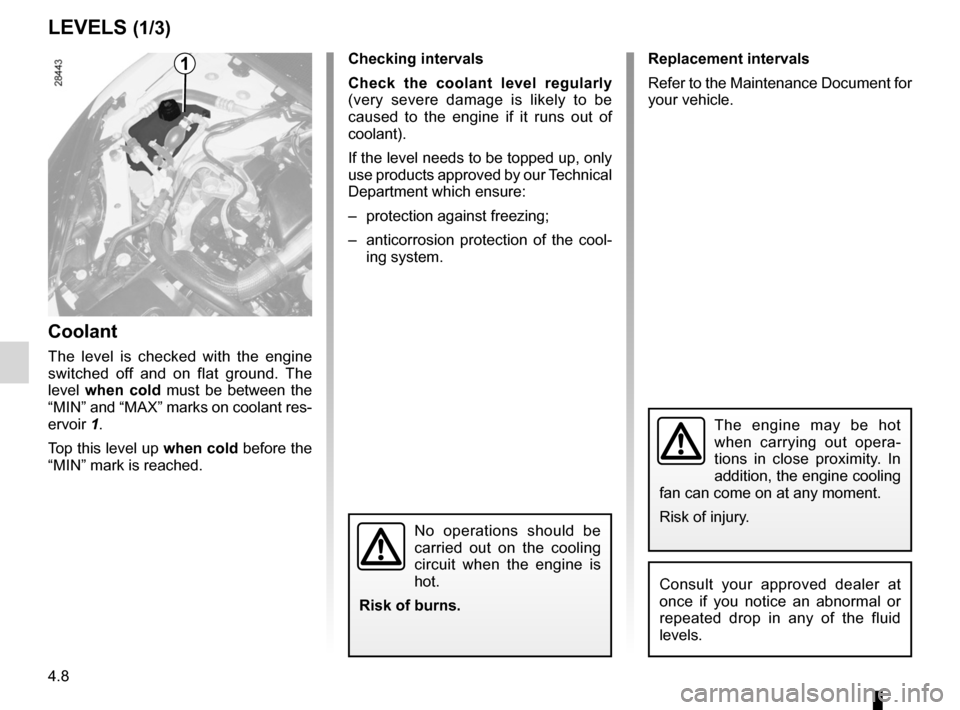
4.8
ENG_UD18857_2
Niveaux / filtres (L38 - X38 - Renault)
ENG_NU_891_892-7_L38-B32_Renault_4
Jaune NoirNoir texte
Levels:
engine coolant
levelS (1/3)
Coolant
The level is checked with the engine
switched off and on flat ground. The
level when cold must be between the
“MIN” and “MAX” marks on coolant res-
ervoir 1.
Top this level up when cold before the
“MIN” mark is reached. Checking intervals
Check the coolant level regularly
(very severe damage is likely to be
caused to the engine if it runs out of
coolant).
If the level needs to be topped up, only
use products approved by our Technical
Department which ensure:
–
protection against freezing;
– anticorrosion protection of the cool -
ing system.
No operations should be
carried out on the cooling
circuit when the engine is
hot.
Risk of burns.
Consult your approved dealer at
once if you notice an abnormal or
repeated drop in any of the fluid
levels.
1Replacement intervals
Refer to the Maintenance Document for
your vehicle.
The engine may be hot
when carrying out opera -
tions in close proximity. In
addition, the engine cooling
fan can come on at any moment.
Risk of injury.
Page 165 of 241
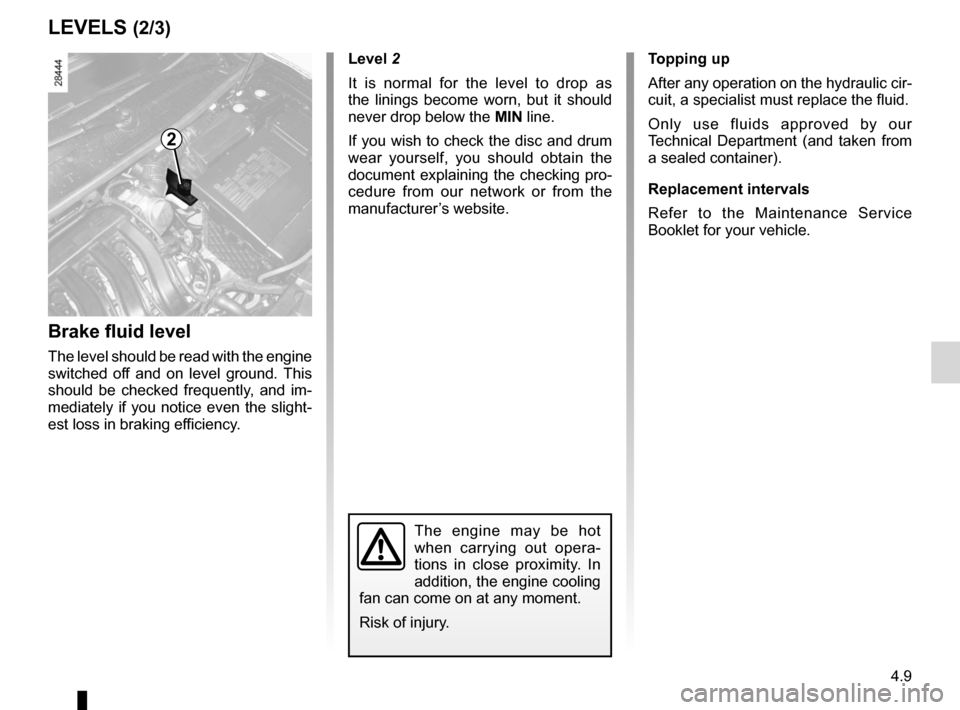
JauneNoirNoir texte
4.9
ENG_UD18857_2
Niveaux / filtres (L38 - X38 - Renault)
ENG_NU_891_892-7_L38-B32_Renault_4
brake fluid
levelS (2/3)
Brake fluid level
The level should be read with the engine
switched off and on level ground. This
should be checked frequently, and im -
mediately if you notice even the slight-
est loss in braking efficiency. level 2
It is normal for the level to drop as
the linings become worn, but it should
never drop below the
Min line.
If you wish to check the disc and drum
wear yourself, you should obtain the
document explaining the checking pro-
cedure from our network or from the
manufacturer’s website. t
opping up
After any operation on the hydraulic cir-
cuit, a specialist must replace the fluid.
Only use fluids approved by our
Technical Department (and taken from
a sealed container).
Replacement intervals
Refer to the Maintenance Service
Booklet for your vehicle.
2
The engine may be hot
when carrying out opera -
tions in close proximity. In
addition, the engine cooling
fan can come on at any moment.
Risk of injury.
Page 168 of 241
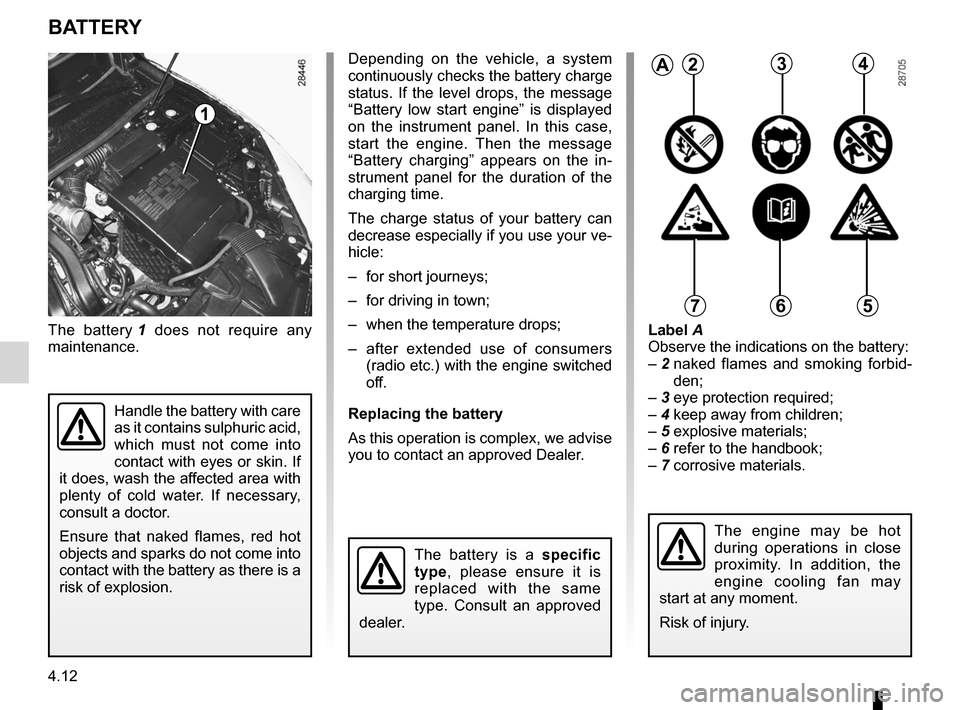
battery................................................... (up to the end of the DU)
4.12
ENG_UD13687_1
Batterie (L38 - X38 - Renault)
ENG_NU_891_892-7_L38-B32_Renault_4
The battery 1 does not require any
maintenance.label A
Observe the indications on the battery:
– 2 naked flames and smoking forbid -
den;
– 3 eye protection required;
– 4 keep away from children;
– 5 explosive materials;
– 6 refer to the handbook;
– 7 corrosive materials.
Battery
The battery is a specific
type , please ensure it is
replaced with the same
type. Consult an approved
dealer.
Handle the battery with care
as it contains sulphuric acid,
which must not come into
contact with eyes or skin. If
it does, wash the affected area with
plenty of cold water. If necessary,
consult a doctor.
Ensure that naked flames, red hot
objects and sparks do not come into
contact with the battery as there is a
risk of explosion.
BA tteR y
Depending on the vehicle, a system
continuously checks the battery charge
status. If the level drops, the message
“Battery low start engine ” is displayed
on the instrument panel. In this case,
start the engine. Then the message
“ Battery charging ” appears on the in -
strument panel for the duration of the
charging time.
The charge status of your battery can
decrease especially if you use your ve-
hicle:
– for short journeys;
– for driving in town;
– when the temperature drops;
– after extended use of consumers
(radio etc.) with the engine switched
off.
Replacing the battery
As this operation is complex, we advise
you to contact an approved Dealer.
1
The engine may be hot
during operations in close
proximity. In addition, the
engine cooling fan may
start at any moment.
Risk of injury.
A234
567
Page 169 of 241
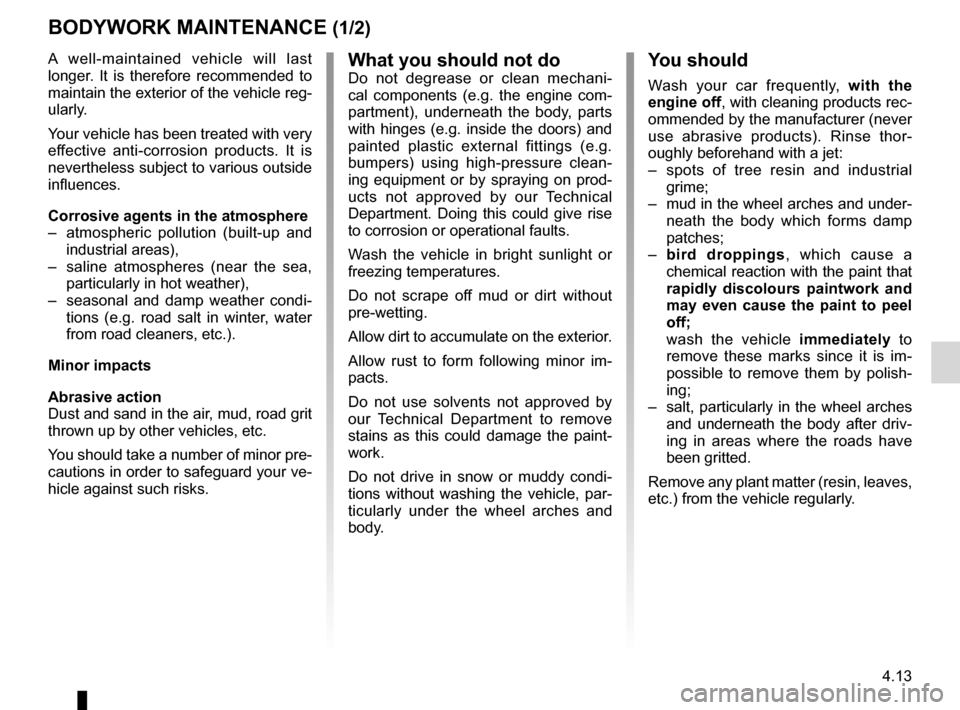
maintenance:bodywork ........................................ (up to the end of the DU)
washing ................................................ (up to the end of the DU)
paintwork maintenance ................................... (up to the end of the DU)
anti-corrosion protection ........................................ (current page)
4.13
ENG_UD26811_2
Entretien de la carrosserie (peinture mate) (X44 - X77 - J77 - X85 - \
B90 - X61 - TEST - X77 ph2 - X95 - B95 - D95 - K95 - J95 - R95 - L90 Ph2 - F90 Ph2 - R90\
Ph2 - X62
ENG_NU_891_892-7_L38-B32_Renault_4
Bodywork maintenance
BODyWORk MAintenAnCe (1/2)
y ou should
Wash your car frequently, with the
engine off, with cleaning products rec-
ommended by the manufacturer (never
use abrasive products). Rinse thor -
oughly beforehand with a jet:
– spots of tree resin and industrial
grime;
– mud in the wheel arches and under -
neath the body which forms damp
patches;
– bird droppings , which cause a
chemical reaction with the paint that
rapidly discolours paintwork and
may even cause the paint to peel
off;
wash the vehicle immediately to
remove these marks since it is im -
possible to remove them by polish -
ing;
– salt, particularly in the wheel arches
and underneath the body after driv -
ing in areas where the roads have
been gritted.
Remove any plant matter (resin, leaves,
etc.) from the vehicle regularly.
What you should not doDo not degrease or clean mechani -
cal components (e.g. the engine com -
partment), underneath the body, parts
with hinges (e.g. inside the doors) and
painted plastic external fittings (e.g.
bumpers) using high-pressure clean -
ing equipment or by spraying on prod-
ucts not approved by our Technical
Department. Doing this could give rise
to corrosion or operational faults.
Wash the vehicle in bright sunlight or
freezing temperatures.
Do not scrape off mud or dirt without
pre-wetting.
Allow dirt to accumulate on the exterior.
Allow rust to form following minor im -
pacts.
Do not use solvents not approved by
our Technical Department to remove
stains as this could damage the paint-
work.
Do not drive in snow or muddy condi -
tions without washing the vehicle, par-
ticularly under the wheel arches and
body.
A well-maintained vehicle will last
longer. It is therefore recommended to
maintain the exterior of the vehicle reg-
ularly.
Your vehicle has been treated with very
effective anti-corrosion products. It is
nevertheless subject to various outside
influences.
Corrosive agents in the atmosphere
–
atmospheric pollution (built-up and
industrial areas),
– saline atmospheres (near the sea,
particularly in hot weather),
– seasonal and damp weather condi -
tions (e.g. road salt in winter, water
from road cleaners, etc.).
Minor impacts
Abrasive action
Dust and sand in the air, mud, road grit
thrown up by other vehicles, etc.
You should take a number of minor pre-
cautions in order to safeguard your ve-
hicle against such risks.
Page 177 of 241
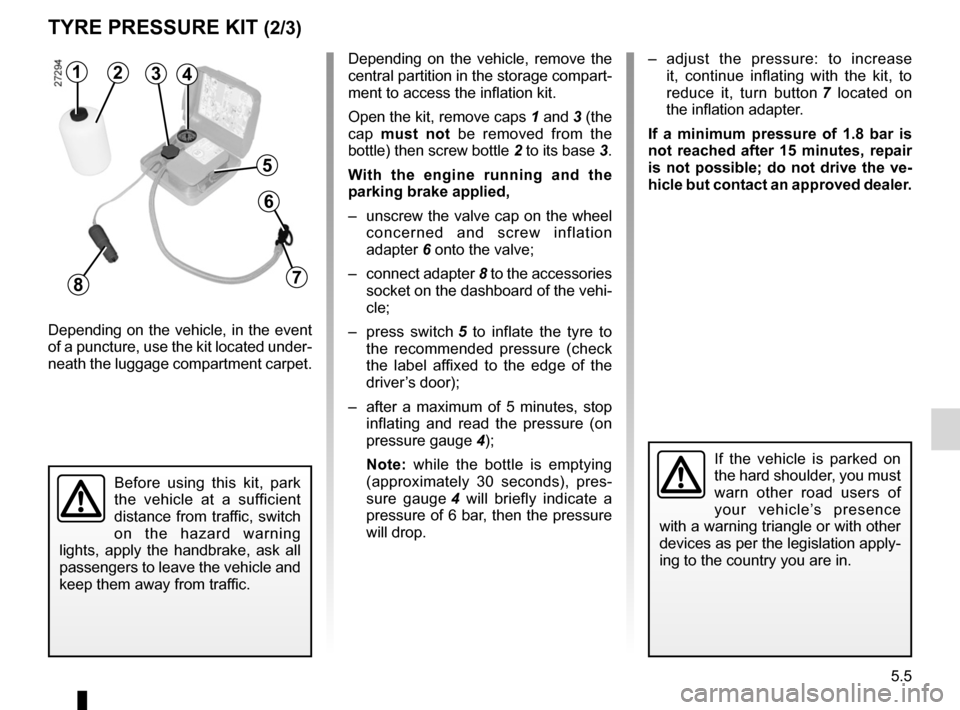
JauneNoirNoir texte
5.5
ENG_UD21559_4
Kit de gonflage (X95 - B95 - D95 - L38 - X38 - X32 - B32 - Renault)
ENG_NU_891_892-7_L38-B32_Renault_5
Depending on the vehicle, remove the
central partition in the storage compart-
ment to access the inflation kit.
Open the kit, remove caps 1 and 3 (the
cap must not be removed from the
bottle) then screw bottle 2 to its base 3.
w ith the engine running and the
parking brake applied,
– unscrew the valve cap on the wheel
concerned and screw inflation
adapter 6 onto the valve;
– connect adapter 8 to the accessories
socket on the dashboard of the vehi-
cle;
– press switch 5 to inflate the tyre to
the recommended pressure (check
the label affixed to the edge of the
driver’s door);
– after a maximum of 5 minutes, stop
inflating and read the pressure (on
pressure gauge 4);
n ote: while the bottle is emptying
(approximately 30 seconds), pres -
sure gauge 4 will briefly indicate a
pressure of 6 bar, then the pressure
will drop.
tyre Pressure KIt (2/3)
143
5
6
78
2– adjust the pressure: to increase
it, continue inflating with the kit, to
reduce it, turn button 7 located on
the inflation adapter.
If a minimum pressure of 1.8 bar is
not reached after 15 minutes, repair
is not possible; do not drive the ve-
hicle but contact an approved dealer.
Depending on the vehicle, in the event
of a puncture, use the kit located under -
neath the luggage compartment carpet.
Before using this kit, park
the vehicle at a sufficient
distance from traffic, switch
on the hazard warning
lights, apply the handbrake, ask all
passengers to leave the vehicle and
keep them away from traffic.
If the vehicle is parked on
the hard shoulder, you must
warn other road users of
your vehicle’s presence
with a warning triangle or with other
devices as per the legislation apply-
ing to the country you are in.
Page 187 of 241
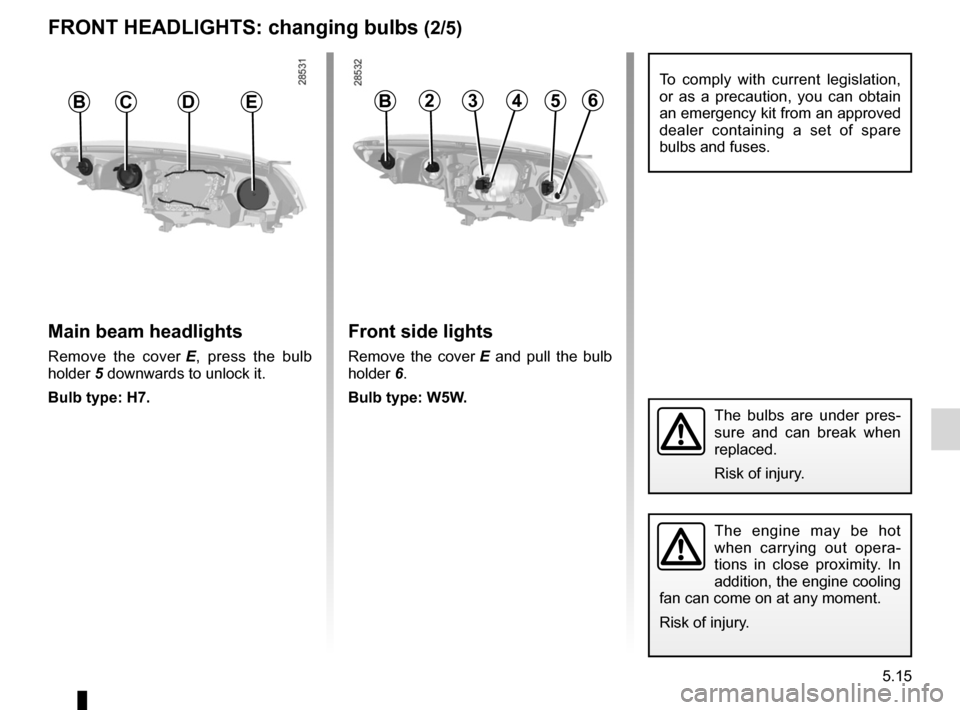
JauneNoirNoir texte
5.15
ENG_UD27193_5
Projecteurs avant : remplacement des lampes (L38 - X38 - Renault)
ENG_NU_891_892-7_L38-B32_Renault_5
The engine may be hot
when carrying out opera -
tions in close proximity. In
addition, the engine cooling
fan can come on at any moment.
Risk of injury.
The bulbs are under pres -
sure and can break when
replaced.
Risk of injury.
To comply with current legislation,
or as a precaution, you can obtain
an emergency kit from an approved
dealer containing a set of spare
bulbs and fuses.
FrOnt heaDlIghts: changing bulbs (2/5)
main beam headlights
Remove the cover E , press the bulb
holder 5 downwards to unlock it.
Bulb type: h7.
BcDe3245B6
Front side lights
Remove the cover E and pull the bulb
holder 6.
Bulb type: w5w .
Page 189 of 241
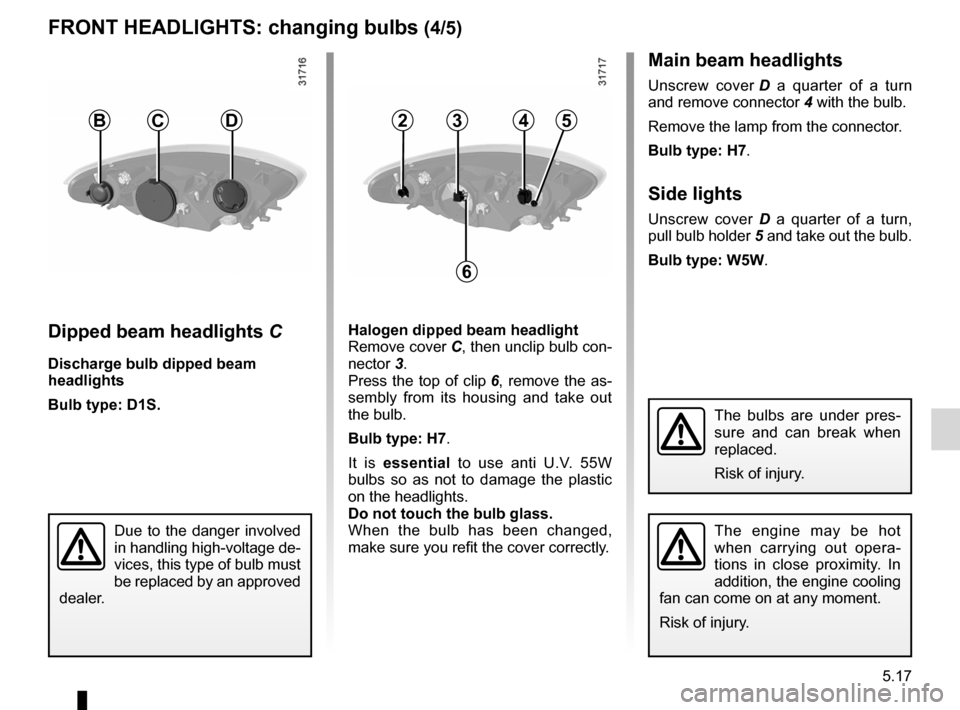
JauneNoirNoir texte
5.17
ENG_UD27193_5
Projecteurs avant : remplacement des lampes (L38 - X38 - Renault)
ENG_NU_891_892-7_L38-B32_Renault_5
FrOnt heaDlIghts: changing bulbs (4/5)
halogen dipped beam headlight
Remove cover C, then unclip bulb con-
nector 3.
Press the top of clip 6, remove the as-
sembly from its housing and take out
the bulb.
Bulb type: h7.
It is essential to use anti U.V. 55W
bulbs so as not to damage the plastic
on the headlights.
Do not touch the bulb glass.
When the bulb has been changed,
make sure you refit the cover correctly.
main beam headlights
Unscrew cover D a quarter of a turn
and remove connector 4 with the bulb.
Remove the lamp from the connector.
Bulb type: h7.
side lights
Unscrew cover D a quarter of a turn,
pull bulb holder 5 and take out the bulb.
Bulb type: w5w.
BcD2543
6
Due to the danger involved
in handling high-voltage de-
vices, this type of bulb must
be replaced by an approved
dealer.
Dipped beam headlights C
Discharge bulb dipped beam
headlights
Bulb type: D1s.
The bulbs are under pres -
sure and can break when
replaced.
Risk of injury.
The engine may be hot
when carrying out opera -
tions in close proximity. In
addition, the engine cooling
fan can come on at any moment.
Risk of injury.
Page 199 of 241
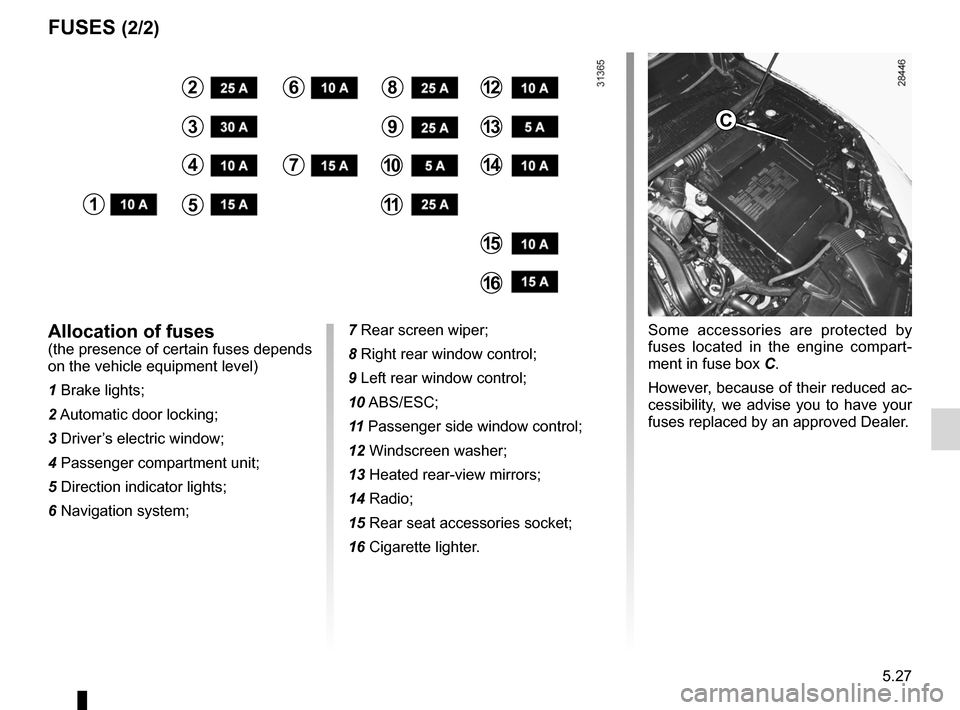
JauneNoirNoir texte
5.27
ENG_UD27260_6
Fusibles (L38 - X38 - Renault)
ENG_NU_891_892-7_L38-B32_Renault_5
Fuses (2/2)
Some accessories are protected by
fuses located in the engine compart -
ment in fuse box C.
However, because of their reduced ac-
cessibility, we advise you to have your
fuses replaced by an approved Dealer.allocation of fuses(the presence of certain fuses depends
on the vehicle equipment level)
1 Brake lights;
2 Automatic door locking;
3 Driver’s electric window;
4 Passenger compartment unit;
5 Direction indicator lights;
6 Navigation system; 7 Rear screen wiper;
8 Right rear window control;
9 Left rear window control;
10 ABS/ESC;
11 Passenger side window control;
12 Windscreen washer;
13 Heated rear-view mirrors;
14 Radio;
15 Rear seat accessories socket;
16 Cigarette lighter.
c
1
2
3
4
5
6
710
11
12
13
14
15
16
8
9
Page 200 of 241
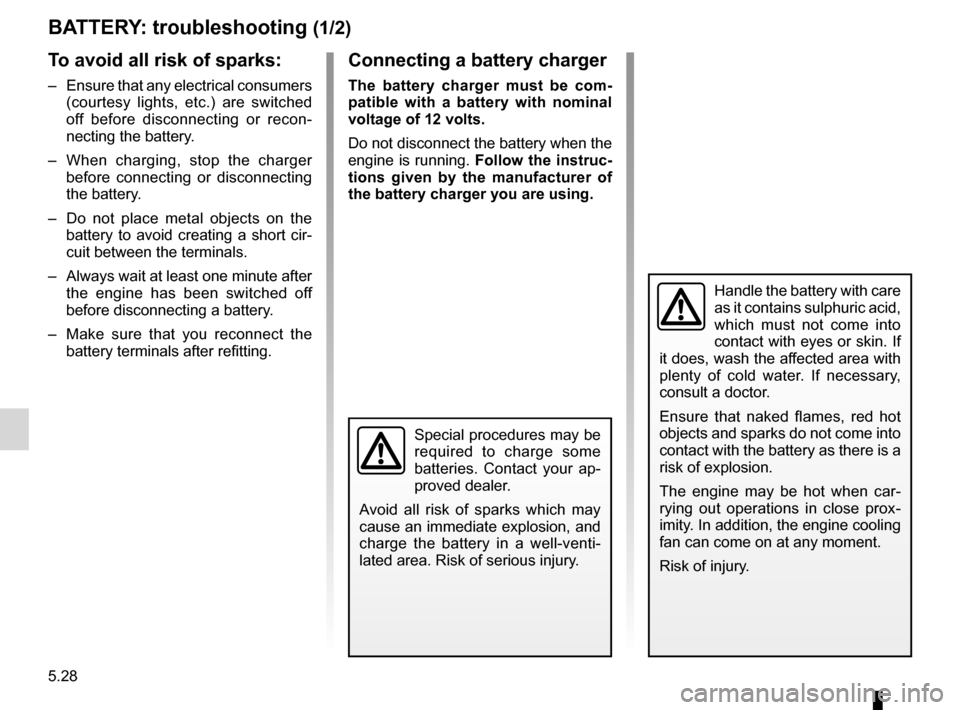
batterytroubleshooting ............................... (up to the end of the DU)
5.28
ENG_UD27186_3
Batterie : dépannage (X95 - B95 - D95 - K95 - L38 - X38 - X32 - B32 \
- Renault)
ENG_NU_891_892-7_L38-B32_Renault_5
Jaune NoirNoir texte
Battery
Battery: troubleshooting (1/2)
to avoid all risk of sparks:
– Ensure that any electrical consumers
(courtesy lights, etc.) are switched
off before disconnecting or recon -
necting the battery.
– When charging, stop the charger
before connecting or disconnecting
the battery.
– Do not place metal objects on the
battery to avoid creating a short cir-
cuit between the terminals.
– Always wait at least one minute after
the engine has been switched off
before disconnecting a battery.
– Make sure that you reconnect the
battery terminals after refitting.
connecting a battery charger
the battery charger must be com -
patible with a battery with nominal
voltage of 12 volts.
Do not disconnect the battery when the
engine is running. Follow the instruc-
tions given by the manufacturer of
the battery charger you are using.
Special procedures may be
required to charge some
batteries. Contact your ap -
proved dealer.
Avoid all risk of sparks which may
cause an immediate explosion, and
charge the battery in a well-venti -
lated area. Risk of serious injury.
Handle the battery with care
as it contains sulphuric acid,
which must not come into
contact with eyes or skin. If
it does, wash the affected area with
plenty of cold water. If necessary,
consult a doctor.
Ensure that naked flames, red hot
objects and sparks do not come into
contact with the battery as there is a
risk of explosion.
The engine may be hot when car -
rying out operations in close prox -
imity. In addition, the engine cooling
fan can come on at any moment.
Risk of injury.
Page 201 of 241
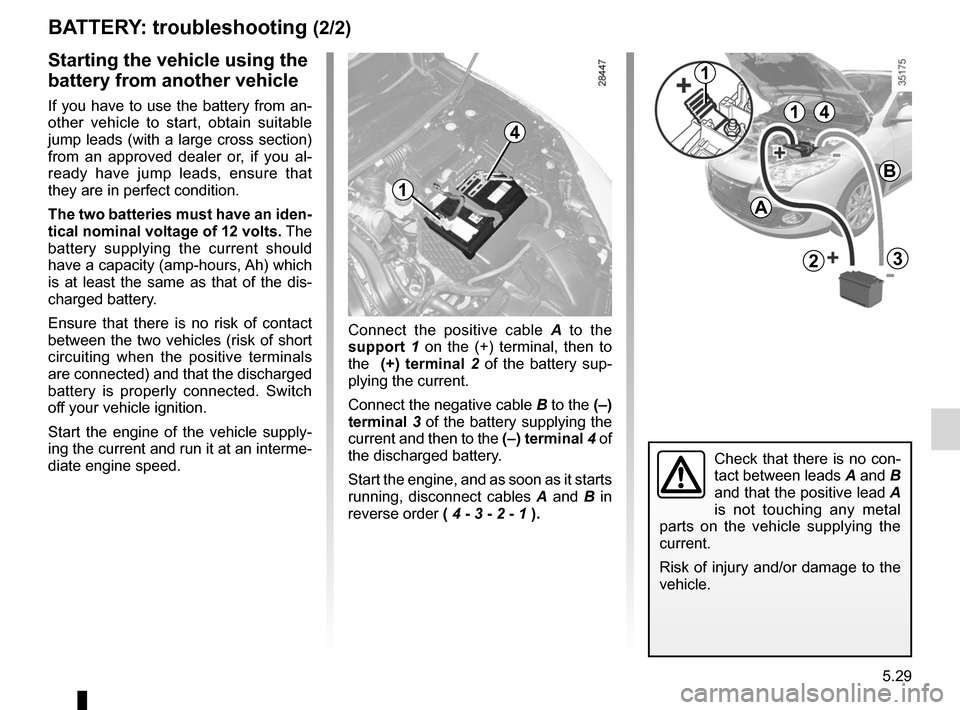
JauneNoirNoir texte
5.29
ENG_UD27186_3
Batterie : dépannage (X95 - B95 - D95 - K95 - L38 - X38 - X32 - B32 \
- Renault)
ENG_NU_891_892-7_L38-B32_Renault_5
Connect the positive cable A to the
support 1 on the (+) terminal, then to
the (+) terminal 2 of the battery sup -
plying the current.
Connect the negative cable B to the (–)
terminal 3 of the battery supplying the
current and then to the (–) terminal 4 of
the discharged battery.
Start the engine, and as soon as it starts
running, disconnect cables A and B in
reverse order ( 4 - 3 - 2 - 1 ).
starting the vehicle using the
battery from another vehicle
If you have to use the battery from an-
other vehicle to start, obtain suitable
jump leads (with a large cross section)
from an approved dealer or, if you al -
ready have jump leads, ensure that
they are in perfect condition.
the two batteries must have an iden-
tical nominal voltage of 12 volts. The
battery supplying the current should
have a capacity (amp-hours, Ah) which
is at least the same as that of the dis-
charged battery.
Ensure that there is no risk of contact
between the two vehicles (risk of short
circuiting when the positive terminals
are connected) and that the discharged
battery is properly connected. Switch
off your vehicle ignition.
Start the engine of the vehicle supply -
ing the current and run it at an interme-
diate engine speed.
Battery: troubleshooting (2/2)
Check that there is no con-
tact between leads A and B
and that the positive lead A
is not touching any metal
parts on the vehicle supplying the
current.
Risk of injury and/or damage to the
vehicle.
1
4
1
14
23
a
B